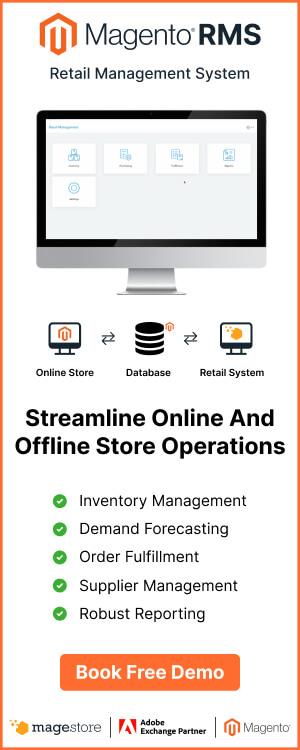
Are you an entrepreneur? …and you want to start a Magento website for your own business.
If so, You made the right decision!
According to a saying of Bill Gates:
“From 5 to 10 years, if you do not trade through the internet then it is better not to do business anymore.”
It’s a piece of completely accurate advice!
In recent years, eCommerce has become so critical to retailers’ success.
Besides owning a brick-and-mortar store, retailers are challenged to create an online website to keep up with trends.
But what for?
To meet the customer’s shopping experience and more.
And Magento platform is known as the best option to start an online store.
Hence, the ultimate goal of this chapter is to give you some tips to build a Magento eCommerce site completely and professionally.
Let’s explore the secrets below:
1. How to start a Magento website (step-by-step)
Today’s online trade is becoming more prevalent, and an eCommerce store is also an indispensable tool.
Thus, after understanding the definition and benefits of Magento, it is the right time to start a successful online store.
With the development of technology, making a website is no longer difficult for online sellers anymore.
Want to know the best part?
… Just follow the 6 simple steps below, you will have yourself a Magento website as expected.

Step 1: Choose a great domain name
Want to sell online and build a brand?
Picking a domain name for your Magento website is critical.
It is your web address as well as your trademark and an important marketing tool.
First, you should choose a name that’s short, catchy, and easy to remember. It should also be unique since the most obvious names are already taken.
A great domain name will give your online retail store:
- An identifiable brand
- Create a professional contact email address associated with the domain
- Support SEO tools for marketing
Step 2: Get Magento installation package and host Magento files on your server
The next step when starting a Magento online store is to implement a Magento installation package from the supplier and put Magento files on your server.
We highly recommend you use a professional Magento development service to make your website available sooner.
Step 3: Pick a Magento template
Let’s perfect the site by performing your brand and products with Magento templates to get closer to the final step.
Step 4: Customize your design to match your brand’s colors and fonts
It’s time to design your store!
Your website is an eCommerce site, you ought to make it as simple and easy to use as possible.
It’s always the best scenario if retailers can provide the best shopping experience for customers.
Additionally, saving their shopping time is a great way for you to sell more.
Here’s the deal:
Product information should be a detailed, clear map, link navigation throughout the website to stimulate users to purchase.
Another tip for you is that the details such as font, color, and layout should be simple but attractive. You can keep reading this guide to choosing the right colors for your brand.
Step 5: Migrate your store and import products
This is usually considered a simple step.
However, to manage the inventory most effectively, you should pay extra attention.
The name, type, characteristics, quantity, and price of the product must be accurate and detailed.
Why?
This aids you greatly in the sales process and helps users find and purchase more easily.
Step 6: Fill out your Magento website settings
In the last step, you just set up the installation mode that is suitable for your store, and start to put your online store into operation.
Bonus:Omnichannel Solution for Magento A complete solution to manage your online-to-offline business effectively in one place with seamless integration. |
2. Manage your Magento website (with 7 Tips)

After owning a commercial eCommerce site, managing it’s just as important as it should be. There are some tips for you:
Get a full-featured eCommerce CMS
Utilizing CMS’s comprehensive enhancements helps to manage your products and categories, add and edit pages, or launch a blog.
It offers customers a seamless choice of products, with SKUs, prices, and images of their own.
The full “How to build Magento 2 website playlist” if you are interested!
Accept payments from leading providers
With the convenience of Magento’s support, you can connect to many applications or utilities without any interference.
Whether it is:
A payment gateway, parameter calculator, shipping tool or connect your eCommerce experience with eBay, Paypal, Mail Chimp, QuickBooks, and more.
If your Magento website supports leading providers like PayPal, Stripe, or Apple Pay, that is a big plus for your online business.
Customers will have a wider selection as well as an overall improvement of their shopping experience.
Manage orders and inventory
Running a retail business means that you have to deal with hundreds of orders every day.
The high volume of sales orders and messy inventory can create chaos during ‘normal’ daily business activities.
Now:
Having software to manage all orders as well as inventory will be needed more than ever before.
Your retail processes or your product management will start to perform as they should be.
This helps your peace of mind which you can use for boosting sales, solve problems and finalize your order as quickly as possible.

Set up shipping integrations
Shipping is an important value-proposition for your store.
Because shipping options depend heavily on your product, business model, target audience, and eCommerce solution.
It has the power to attract customers, but it can also push customers away.
So if you are new to selling online, think about starting small.
That means you may want to stick with domestic shipping and master that before you dive into the international market.
There are some tips to keep in mind when you’re getting started with online shipping.
- Start by researching your competitors, you can discover some great insights about what works and not.
- Make your shipping policies very straightforward, this will prevent confusion, making your potential customer more likely to purchase.
- Ofer a variety of shipping options based on different shipping speeds or carriers. How quickly a shopper gets their product can be just as important as how much they pay for shipping.
Now, if you can offer free shipping on your products, do it!
According to a study by Forrester Research, high shipping costs are the number one reason for abandoning the cart.
You can increase your average order value by free shipping or by offering a free shipping service with a minimum order amount.
Getting something free has a huge impact on the psychology of buying.
Setup taxes properly
We’re talking about taxes for your business at this point, not local sales tax.
So this step is pretty short and “sweet” — you should talk to a tax expert.
They will help you do things like attain your tax ID and understand your area’s tax classes, rates, and structure.
All of this can vary from location to location.
Trust me, you’ll save money and headaches in the long run by consulting the expert.
Set up analytics to measure your success
You need data and benchmarks to nurture your business.

To get started, check out the analysis in the repository of your platform.
With Magento, it can help you with basic metrics like your visitors, conversion rates, popular products, and average profit.
Considering platform options like in-store site search that can give you insight into what your customers are looking for.
Want to know the best part?
No matter what you do, Google Analytics is the key to your online business success.
This will help you understand what the search giant sees happening both inside and outside of your Magento web-store
Google Analytics provides you with the following insights to help you expand and improve your business:
- Get to know your target audience
- Track where shoppers come from, where they go and where they leave
- Track how visitors interact with your store
- Ability to annotate your efforts
Secure your Magento website by installing an SSL certificate
SSL – Secure Sockets Layer – Certificates are small data files that digitally bind a cryptographic key to an organization’s details.
When installed on a web server, it activates the padlock and the HTTPS protocol (over port 443),.
This allows customers to verify the authenticity and reliability of the brand.
What’s the bottom line?
All data and information exchanged between the website and the customer is encrypted, avoiding the risk of interference and allows secure connections from a web server to a browser.
Typically, SSL is used to secure credit card transactions, data transfer, and logins.
More recently, it is becoming the norm when securing browsing of social media sites. SSL Certificates bind together:
- A domain name, server name, or hostname.
- An organizational identity (i.e. company name) and location.
3. Increase your sales across channels with Magento features
Easily checkout
The shopping cart page is the most crucial part of an eCommerce store that decides your customer purchase.
By providing easy and simple checkout utilities, you allow consumers to complete the purchase process more conveniently.
This reduces your abandoned cart and converted sales ratio.
A good converting website needs an One Step Checkout page that simplifies the complex step-by-step process which includes repeating fields for a single step payment process.
This reduces the number of customers abandoning their carts midway through.
The more customers complete the payment process, the higher businesses increase their revenue.
Sell on social media
There are many tips and tricks you can use to attract your web visitors to your online store. One of the best tips is to use social media.
Social media are low-cost tools used to combine technology with social interaction through the use of words.
The most commonly used tools are the internet and other mobile devices.
You’ve probably heard of popular news channels such as Twitter, Facebook, Myspace, and Youtube, the marketplace.

The media itself has created a way for marketers to communicate with their customers and potential consumers.
It also helps to personalize the brand as well as convey the message in a comfortable conversational style.
So, it is a great way to promote your products to your target as well as new web customers.
List on global marketplaces like Amazon, eBay… without managing separate inventories
Online marketplaces have become an integral part of many eCommerce businesses, where consumers can shop online from many merchants in one place.
According to “Internet Retailer”, the sales of the two largest marketers: Amazon and eBay, are accounted for about 27% of North American online retail sales in 2015.
Here’s the deal:
Along with product information management, sellers must have a strategy to manage their inventory in many markets.
Keep customers coming back with gift cards, coupons, store credits, points
Retaining old customers to continue shopping on your Magento website is much easier than finding new customers.
This is true for most businesses especially in the online business environment, where advertising costs frequently increase.
The search for new customers is becoming more expensive and competitive.
Membership cards, loyalty programs, double discounts, … are measures being applied by many retail stores to attract customers.
Bonus:Loyalty guide for Magento Start a Loyalty Program for your Online to Offline Business. |
Centralized channel management
Retailers need to do better in linking online and offline shopping channels.
To improve the situation, it is important to have a Magento point of sale system that streamlines separate sales channels to provide seamless shopping experiences anytime and anywhere.
Businesses can save time in processing data pooling for easier management and savings for customers.
And if you’re still wondering, the Omnichannel trend is emerging as a cool breeze that will help you solve the problem.
Convert mobile shoppers
Today’s customers are always “online”

84% of them cannot live without a smartphone.
8-10 am: 66% will wake up with their smartphone
12-5 pm: peak hours of using the smartphone during the day
Those figures prove the huge potential of mobile shoppers when about 29% of Americans will buy everything online if they can.
Best of all:
Mobile consumers want a great experience when landing on a certain website and 66% of them would like today’s retailers to offer the greatest shopping experience on the smartphone.
If the site is fully satisfied, they will likely continue browsing the site.
However, if the site is not that mobile-friendly, visitors will start leaving the web completely.
To meet the growing demand of customers, what you need to do is know how to make the most out of the technology to maximize the shopping experience for your users.
With Magento, your eCommerce store will always be optimized for mobile phones.
Sync all your sales
Last but not least, retailers should integrate all their sales to check the number of products left in stock. Therefore, it can avoid losing sales.
4. Seamlessly integrate your online and offline experiences

To enhance the shopping experience for your customers, we need a total solution that you need to narrow the gap of distance as well as seamlessly integrate between online and offline shopping experiences.
Today, Omnichannel is considered to be the most effective and appropriate solution to meet the complex technology needs of retailers.
“I think eCommerce for many years was an interesting trend, but it was on the side, largely, of what was happening in retail. Today we don’t even know what eCommerce means. They’ve just come together, the online and the offline. Now, every merchant, every retailer must have an OmniChannel strategy or they won’t survive.”
– Devin Wenig, President, eBay Marketplaces
Here are some suggestions for you:
Get Your Technology Together
Integrating your back-end systems is the most important step.
Both your physical store and your e-commerce store need to share data and function in simultaneity.
Inventory stock is just one example of the many retail aspects that need to be synced.
Generally, the back-end unification challenge is in syncing your e-commerce content management system with your in-store Magento point of sale (POS) system.
Hence, the secret to starting unification right is to invest in one system that integrates everything for you.
Enhance the In-Store Experience
If you’re a brick-and-mortar retailer, in-store shoppers are incredibly valuable.
You just have to get them to come in.
This is accomplished by improving online shopping experiences to in-store shoppers, such as:
- Offering the ability to receive an order online from a store.
- Allowing customers to pick up online orders from the brick-and-mortar location.
- Providing in-store availability as well as a website option for those who want to buy the product right away and do not want to wait.
- Accepting mobile payments through your in-store Magento POS system
- Creating an app that lets shoppers scan product barcodes to read online reviews.
- Offering in-store access to your online catalog.
- Providing the ability to return a product to a store.
- Creating an online shopping list that’s easy to use in the store.
- Providing free Wi-Fi
Combine Online & Offline Marketing

Consumers have more demands than ever before, and they expect personalized content.
Growth hacking successfully requires overlap in online and offline tactics to stand out and make a lasting impression on customers.
Here are some ways to blend online and offline strategies:
- Online coupons to the physical store can be offered as SMS, via email marketing, as push notifications from applications, or on Facebook.
- Offering the possibility to buy online gift cards to stores and vice versa.
- Timely SMS messages with discount codes work great for some markets – test with your target group!
- Advertising digital in-store innovations to online shoppers.
- Promoting social contests in your physical locations.
- Creating Facebook event pages for in-store events and sales.
- Using geolocation targeting to send mobile offers to nearby potential customers.
It takes the investment and long-term dedication for unifying online and offline retail, but if you follow these three fundamental guidelines – starting step-by-step with the right strategy, and building from there – you’ll find success.
Are you ready to start your own Magento website?
Starting a Magento website doesn’t have to be overwhelming. Especially not with our guide.
Don’t miss out on this opportunity!
Let’s begin to build a Magento eCommerce site to grow your own business.
We’re just a click away to provide you with a free consultation on how to set up your business.

















This is a very impressive post which gives me a lot of knowledge about how to start a magento website online store.